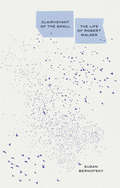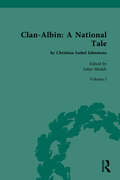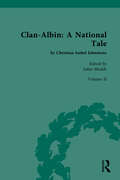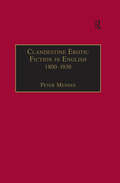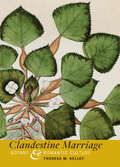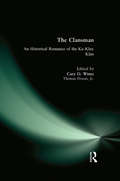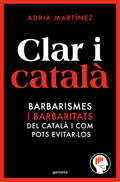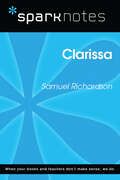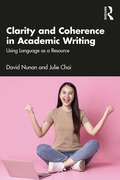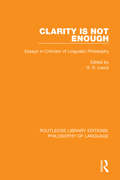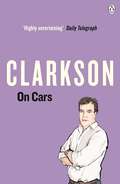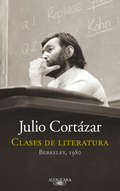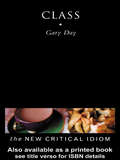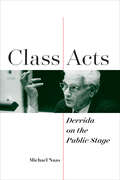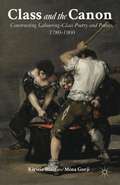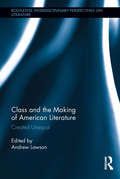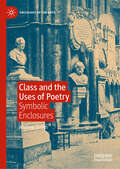- Table View
- List View
The Clairmont Family Letters, 1839 - 1889: Volume II (The Pickering Masters)
by Sharon JoffeThis book is the second of two volumes in an edited collection that brings together the unpublished letters of the extended Clairmont family, for the first time. The letters, housed in the Carl H. Pforzheimer Collection of Shelley and His Circle at the New York Public Library, inform our understanding of the Shelley-Godwin circle through the experiences and thoughts of their descendants. The correspondence also enables us to see into the contemporary social history of nineteenth-century families living in Europe and Australia, dealing with subjects such as the conflicts in Europe, woes in the European financial markets, and the effects of Australian pioneer life on immigrants to that country. The Clairmont Family Letters, 1839–1889 improves upon scholarship made by other Shelley and Clairmont collections and is furnished with editorial notes and apparatus from Dr. Sharon Joffe. These volumes will be of significant interest to scholars in British Romanticism.
Clairvoyant of the Small: The Life of Robert Walser
by Susan BernofskyThe first English-language biography of one of the great literary talents of the twentieth century, written by his award-winning translator"Masterful. . . . This balanced and meticulous account shines a bright light on a misunderstood and influential writer.."--Publishers Weekly, Starred Review The great Swiss-German modernist author Robert Walser lived eccentrically on the fringes of society, shocking his Berlin friends by enrolling in butler school and later developing an urban-nomad lifestyle in the Swiss capital, Bern, before checking himself into a psychiatric clinic. A connoisseur of power differentials, his pronounced interest in everything inconspicuous and modest—social outcasts and artists as well as the impoverished, marginalized, and forgotten—prompted W. G. Sebald to dub him &“a clairvoyant of the small.&” His revolutionary use of short prose forms won him the admiration of Franz Kafka, Walter Benjamin, Robert Musil, and many others. He was long believed an outsider by conviction, but Susan Bernofsky presents a more nuanced view in this immaculately researched and beautifully written biography. Setting Walser in the context of early twentieth century European history, she provides illuminating analysis of his extraordinary life and work, bearing witness to his &“extreme artistic delight.&”
Clan-Albin: by Christian Isobel Johnstone (Chawton House Library: Women's Novels)
by Juliet ShieldsChristian Isobel Johnstone’s Clan-Albin: A National Tale was published in 1815, less than a year after Walter Scott’s Waverley; or ‘tis Sixty Years Since enthralled readers and initiated a craze for Scottish novels. Both as a novelist and as editor of Tait’s Edinburgh Magazine from 1834 to 1846, Johnstone was a powerful figure in Romantic Edinburgh’s literary scene. But her works and her reputation have long been overshadowed by Scott’s. In Clan-Albin, Johnstone engages with themes on British imperial expansion, metropolitan England’s economic and political relationships with the Celtic peripheries, and the role of women in public life. This rare novel, alongside extensive editorial commentary, will be of much interest to students of British Literature.
Clan-Albin: by Christian Isobel Johnstone (Chawton House Library: Women's Novels)
by Juliet ShieldsChristian Isobel Johnstone’s Clan-Albin: A National Tale was published in 1815, less than a year after Walter Scott’s Waverley; or ‘tis Sixty Years Since enthralled readers and initiated a craze for Scottish novels. Both as a novelist and as editor of Tait’s Edinburgh Magazine from 1834 to 1846, Johnstone was a powerful figure in Romantic Edinburgh’s literary scene. But her works and her reputation have long been overshadowed by Scott’s. In Clan-Albin, Johnstone engages with themes on British imperial expansion, metropolitan England’s economic and political relationships with the Celtic peripheries, and the role of women in public life. This rare novel, alongside extensive editorial commentary, will be of much interest to students of British Literature.
Clandestine Erotic Fiction in English 1800–1930: A Bibliographical Study
by Peter MendesThis work offers bibliographical descriptions of all printings of erotic fiction in English issued clandestinely during the period 1800-1930. By 'clandestine' is meant books whose publishers and printers attempt to hide their identities, usually by offering title pages whose misleading places and dates of publication may shock and amuse, but which always aim to mystify. Using internal and external evidence, an attempt is made to establish who were the printers, booksellers and publishers, English and Continental, involved in this trade. The printing families or 'groups' into which a large percentage of the material falls are classified, accompanied by illustrations which identify the main printing characteristics ('house styles') of the groups. Bibliographical descriptions follow a checklist of clandestine catalogues; these provide valuable evidence for dating, pricing and 'sales pitch' and information on items of which no copies can now be traced. The work concludes with a series of appendices which provide significant external evidence, and three indexes: of themes, titles and names. Peter Mendes' original research builds on and significantly extends the essential pioneer work of the Victorian collector and bibliographer H.S. Ashbee ('Pisanus Fraxi').
Clandestine Marriage: Botany and Romantic Culture
by Theresa M. KelleyBotany in the romantic era played a role in debates about life, nature, and knowledge, as evidenced in this ambitious, beautifully illustrated study.Winner, 2012 British Society for Literature and Science Book PrizeRomanticism was a cultural and intellectual movement characterized by discovery, revolution, and the poetic as well as by the philosophical relationship between people and nature. Botany sits at the intersection where romantic scientific and literary discourses meet. Clandestine Marriage explores the meaning and methods of how plants were represented and reproduced in scientific, literary, artistic, and material cultures of the period. Theresa M. Kelley synthesizes romantic debates about taxonomy and morphology, the contemporary interest in books and magazines devoted to plant study and images, and writings by such authors as Mary Wollstonecraft and Anna Letitia Barbauld. Period botanical paintings of flowers are reproduced in vibrant color, bringing her argument and the romantics' passion for plants to life.In addition to exploring botanic thought and practice in the context of British romanticism, Kelley also looks to the German philosophical traditions of Kant, Hegel, and Goethe and to Charles Darwin’s reflections on orchids and plant pollination. Her interdisciplinary approach allows a deeper understanding of a time when exploration of the natural world was a culture-wide enchantment.
Clandestine Philosophy: New Studies on Subversive Manuscripts in Early Modern Europe, 1620–1823 (UCLA Clark Memorial Library Series)
Clandestine philosophical manuscripts, made up of forbidden works including erotic texts, political pamphlets, satires of court life, forbidden religious texts, and books about the occult, had an avid readership in the seventeenth and eighteenth centuries, becoming objects of historical research by the twentieth century. The purveyors of the clandestine could be found in the Dutch Republic, Switzerland, Denmark, Spain, and not least in Paris or London. Despite the heavy risks, including prison, the circulation of these manuscripts was a prosperous venture. After Ira Wade’s pioneering contribution (1938), Clandestine Philosophy is the first work in English entirely focused on the philosophical clandestine manuscripts that preceded and accompanied the birth of the Enlightenment. Topics from philosophy, political and religious thought, and moral and sexual behaviour are addressed by contemporary authors working in both America and Europe. These manuscripts shed light on the birth of pornography and provide an important avenue for investigating philosophical, religious, political, and social critique.
Clang! Clang! Beep! Beep! Listen to the City: Listen To The City (Elementary Core Reading Ser.)
by Robert Burleigh Beppe GiacobbeNIMAC-sourced textbook <P><P>From morning until night, a city is filled with such sounds as the roars and snores of a subway ride, the flutters and coos of pigeons, and the shouts and beeps of drivers in traffic.
The Clansman: An Historical Romance of the Ku Klux Klan
by Thomas Dixon Thomas WintzThomas Dixon was a lawyer, North Carolina state legislator, Baptist minister, lecturer, and novelist. This novel, an abridgement by Cary Wintz was originally published in 1905. It reflects turn-of-the-century attitudes most southerners had about Republican rule during Reconstruction.
Clar i català: Els barbarismes (i barbaritats) més freqüents i com pots evitar-los
by Jo Aprenc Català @joaprenccatalaAra és l’hora de parlar clar i català! Descobreix els barbarismes més comuns i com evitar-los en un llibre imprescindible. 100 BARBARISMES PER APRENDRE A PARLAR MILLOR LA LLENGUA (CATALANA) Parles sovint en català, però de tant en (quant) tant deixes anar un barbarisme? Et (dona apuro) fa vergonya cometre errors però no saps com evitar-los? (Menos mal) Encara sort que tens aquest llibre!Deixa't de (tonteries) ximpleries i comença a (exprimir) esprémer la llengua com mai. Descobreix 100 barbarismes de la llengua catalana, aprèn les seves formes en català i enriqueix el teu vocabulari amb les expressions més genuïnes i divertides de la nostra llengua. HA ARRIBAT L'HORA DE DONAR UNA (PATADA) PUNTADA DE PEU ALS BARBARISMES I PARLAR LA LLENGUA COM CAL!
Clarissa (SparkNotes Literature Guide Series)
by SparkNotesClarissa (SparkNotes Literature Guide) by Samuel Richardson Making the reading experience fun! Created by Harvard students for students everywhere, SparkNotes is a new breed of study guide: smarter, better, faster.Geared to what today's students need to know, SparkNotes provides:chapter-by-chapter analysis explanations of key themes, motifs, and symbols a review quiz and essay topics Lively and accessible, these guides are perfect for late-night studying and writing papers.
Clarissa on the Continent: Translation and Seduction (G - Reference, Information and Interdisciplinary Subjects)
by Thomas O. Beebee"Clarissa" on the Continent defines and explores two strategies of literary translation—creative vs. preservative and strong vs. weak—as they transform one of the most influential English novels. Thomas Beebee compares the two opposing strategies as they influence the French translation of Clarissa by the novelist Antione François de Prévost and the German translation by the Göttingen Orientalist Johann David Michaelis, and in doing so he demonstrates that each translator found authority for his procedure within the text itself. Each translation is also examined in light of Richardson's other writings and placed in its literary and cultural context. This study uses translations in order to interpret Clarissa, to show how the basis for the novel's reception on the Continent was laid, and to explore the differences and interactions among three literary and cultural systems of the eighteenth century. The close examination of these two important translations enable the formulation of not only a theory of creative vs. preservative translation but also the interconnections between literary theory and translation theory. Beebee also looks at later translations of Clarissa as products of literary and historical change and at Prévostian strategies of the novel.
Clarissa's Ciphers: Meaning and Disruption in Richardson's Clarissa
by Terry CastleAs Samuel Richardson's 'exemplar to her sex,’ Clarissa in the eponymous novel published in 1748 is the paradigmatic female victim. In Clarissa’s Ciphers, Terry Castle delineates the ways in which, in a world where only voice carries authority, Clarissa is repeatedly silenced, both metaphorically and literally. A victim of rape, she is first a victim of hermeneutic abuse. Drawing on feminist criticism and hermeneutic theory, Castle examines the question of authority in the novel. By tracing the patterns of abuse and exploitation that occur when meanings are arbitrarily and violently imposed, she explores the sexual politics of reading.
Clarity and Coherence in Academic Writing: Using Language as a Resource
by David Nunan Julie ChoiThis book presents a lively, rich, and concise introduction to the key concepts and tools for developing clarity and coherence in academic writing. Well-known authors and linguists David Nunan and Julie Choi argue that becoming an accomplished writer is a career-long endeavor. They describe and provide examples of the linguistic procedures that writers can draw on to enhance clarity and coherence for the reader. Although the focus is on academic writing, these procedures are relevant for all writing. This resource makes complex concepts accessible to the emergent writer and illustrates how these concepts can be applied to their own writing. The authors share examples from a wide range of academic and non-academic sources, from their own work, and from the writing of their students. In-text projects and tasks invite you, the reader, to experiment with principles and ideas in developing your identity and voice as a writer.
Clarity Is Not Enough: Essays in Criticism of Linguistic Philosophy (Routledge Library Editions: Philosophy Of Language Ser.)
by H. D. LewisThis book, originally published in 1963 provides a sample of the criticisms of philosophers on the course of linguistic philosophy. A chronological ordr is followed, with work ranging from that of traditionalist thinkers to second thoughts about linguistic philosophy on the part of writers who have been influenced by the movement.
The Clark's Yard Sale (Phonic Practice Reader #18)
by Judy NayerThe Clark's stumble upon a Yard Sale.
Clarkson on Cars
by Jeremy ClarksonJeremy Clarkson gets under the bonnet in Clarkson on Cars - a collection of his motoring journalism.Jeremy Clarkson has been driving cars, writing about them and occasionally voicing his opinions on the BBC's Top Gear for twenty years.No one in the business is taller.In this collection of classic Clarkson, stretching back to the mid-1980s, he's pulled together the car columns and stories with which he made his name. As coal mines closed and house prices exploded to a soundtrack of men in make-up playing synthesizers, Jeremy was already waxing lyrical on topics as useful and diverse as:* The perils of bicycle ownership * Why Australians - not Brits - need bull bars* Why soon only geriatrics will be driving BMWs* The difficultly of deciding on the best car for your wedding * Why Jesus's dad would have owned a Nissan Bluebird * And why it is that bus lanes cause traffic jamsIrreverent, damn funny and offensive to almost everyone, this is writing with its foot to the floor, the brake lines cut and the speed limit smashed to smithereens. Sit back and enjoy the ride. Praise for Jeremy Clarkson:'Brilliant . . . laugh-out-loud' Daily Telegraph'Outrageously funny . . . will have you in stitches' Time Out'Very funny . . . I cracked up laughing on the tube' Evening Standard
Clases de Literatura: Berkeley, 1980
by Julio CortázarCortázar inédito. El Cortázar que nos quedaba por conocer, este que entra en el aula y sonríe. Berkeley, California, otoño de 1980. En la cima de su carrera y después de años de negativas, Julio Cortázar acepta dar un curso universitario de dos meses en los Estados Unidos. Como cabía esperar, no se tratará de conferencias magistrales sino de una serie de charlas sobre literatura, y sobre todo acerca de su experiencia de escritor y la génesis de sus obras. Las clases tratan gran diversidad de temas: aspectos del cuento fantástico; la musicalidad, el humor, el erotismo y lo lúdico en la literatura; la imaginación y el realismo, la literatura social y las trampas del lenguaje, todos ellos encarnados en lecturas y ejemplos tomados de la cultura universal. Las clases llegan a su punto máximo de interés cuando Cortázar, ya en la edad de los balances, se refiere a su evolución de escritor y analiza su obra: cómo nacieron los cronopios y cuentos insuperables como "La noche boca arriba" o "Continuidad de los parques"; el sentido de Rayuela y su proceso de escritura; el desafío de Libro de Manuel. Quien lea la minuciosa y fiel transcripción de trece horas de grabaciones, al cabo de este encuentro con el Cortázar oral, valorará lo mismo que en sus textos: la soltura y cercanía, la vastedad de lecturas, la honestidad intelectual, la imaginación y el rigor de tamaño profesor.
Class (The New Critical Idiom)
by Gary DayThis book traces the phenomenon of class from the medieval to the postmodern period, uniquely examining its relevance to literary and cultural analysis. Drawing on historical, sociological and literary writings, Gary Day:* gives an account of class at different historical moments* shows the role of class in literary constructions of the social* examines the complex relations between 'class' and 'culture'* focuses attention on the role of class in constructions of 'the literary' and 'the canon'* employs a revived and revised notion of class to critique recent theoretical movements.
Class Acts: Derrida on the Public Stage (Perspectives in Continental Philosophy)
by Michael NaasClass Acts examines two often neglected aspects of Jacques Derrida’s work as a philosopher, his public presentations at lectures and conferences and his teaching, along with the question of the “speech act” that links them. What, Michael Naas asks, is one doing when one speaks in public in these ways?The book follows Derrida’s itinerary with regard to speech act theory across three public lectures, from 1971 to 1997, all given, for reasons the book seeks to explain, in Montreal. In these lectures, Derrida elaborated his critique of J. L. Austin and his own subsequent redefinition of speech act theory. The book then gives an overview of Derrida’s teaching career and his famous “seminar” presentations, along with his own explicit reflections on pedagogy and educational institutions beginning in the mid-1970s. Naas then shows through a reading of three recently published seminars—on life death, theory and practice, and forgiveness—just how Derrida the teacher interrogated and deployed speech act theory in his seminars. Whether in a conference hall or a classroom, Naas demonstrates, Derrida was always interested in the way spoken or written words might do more than simply communicate some meaning or intent but might give rise to something like an event. Class Acts bears witness to the possibility of such events in Derrida’s work as a pedagogue and a public intellectual.
The Class and Gender Politics of Chinese Online Discourse: Ambivalence, Sociopolitical Tensions and Co-option (Routledge Studies in New Media and Cyberculture)
by Yanning HuangThis book offers an in- depth study of the quasi- political, self-deprecating, and parodic buzzwords and memes prevalent in Chinese online discourse.Combining discourse analysis with in- depth audience research among the young internet users who deploy these buzzwords in on- and offline contexts, the book explores the historical and social implications of online wordplay for sustaining or challenging the contemporary social order in China. Yanning Huang adopts a combination of media and communications, social anthropology, and socio- linguistic perspectives to shed light on various forms of agency enacted by different social groups in their embracing, negotiation of, or disengagement from online buzzwords, before addressing how the discourses of online wordplay have been co-opted by corporations and party-media.Offering a rigorous and panoramic analysis of the politics and logics of online wordplay in contemporary China, and providing a critical and nuanced analytical framework for studying digital culture and participation in China and elsewhere, this book will be an important resource for scholars and students of media and communication studies, Internet and digital media studies, discourse analysis, Asian studies, and social anthropology.
Class and the Canon
by Kirstie Blair Mina GorjiExamining how labouring-class poets constructed themselves and were constructed by critics as part of a canon, and how they situated their work in relation to contemporaries and poets from earlier periods, this book highlights the complexities of labouring-class poetic identities in the period from Burns to mid-late century Victorian dialect poets.
Class and the Making of American Literature: Created Unequal (Routledge Interdisciplinary Perspectives on Literature)
by Andrew LawsonThis book refocuses current understandings of American Literature from the revolutionary period to the present-day through an analytical accounting of class, reestablishing a foundation for discussions of class in American culture. American Studies scholars have explored the ways in which American society operates through inequality and modes of social control, focusing primarily on issues of status group identities involving race/ethnicity, gender, sexuality, and disability. The essays in this volume focus on both the historically changing experience of class and its continuing hold on American life. The collection visits popular as well as canonical literature, recognizing that class is constructed in and mediated by the affective and the sensational. It analyzes class division, class difference, and class identity in American culture, enabling readers to grasp why class matters, as well as the economic, social, and political matter of class. Redefining the field of American literary cultural studies and asking it to rethink its preoccupation with race and gender as primary determinants of identity, contributors explore the disciplining of the laboring body and of the emotions, the political role of the novel in contesting the limits of class power and authority, and the role of the modern consumer culture in both blurring and sharpening class divisions.
Class and the Uses of Poetry: Symbolic Enclosures (Sociology of the Arts)
by Andrew SmithThis book provides new empirical evidence about the ways in which social inequalities, especially those of class, shape and delimit forms of cultural reception and creative opportunity. How does it come about that, in George Orwell’s words, ‘the divorce between poetry and popular culture is accepted as a sort of law of nature’? Drawing on qualitative research conducted in and around Glasgow, Poetry, Class and Symbolic Violence explores how working-class readers engaged with, made sense of, and contested a sense of exclusion from, contemporary poetry. In doing so it sheds light on the symbolic enclosure of poetry, on how that enclosure takes shape in the encounter between readers and poems, but also on why poetry continues to matter. Through these conversations, and in further interviews with unpublished poets, it reflects on the creative and expressive affordances of poetry, on what can be done with poetry and what it can make possible. Sociologists have had little to say about poetry as a distinctive esthetic practice. Poetry, Class and Symbolic Violence tries to break that silence and to make a start on constructing a critical sociology of poetry for today.
Class, Culture and Suburban Anxieties in the Victorian Era (Routledge Studies in Nineteenth Century Literature)
by Lara Baker WhelanThis book demonstrates how representations of the Victorian suburb in mid- to late-nineteenth century British writing occasioned a literary sub-genre unique to this period, one that attempted to reassure readers that the suburb was a place where outsiders could be controlled and where middle-class values could be enforced. Whelan explores the dissonance created by the differences between the suburban ideal and suburban realities, recognizing the persistence of that ideal in the face of abundant evidence that it was hardly ever realized. She discusses evidence from primary and secondary sources about perceptions and realities of suburban living, showing what it meant to live in a "real" Victorian suburb. The book also demonstrates how the suburban ideal (with its elements of privacy, cleanliness, rus in urbe, and respectability), in its relation to culturally embedded ideas about the Beautiful and Picturesque, gained such a strong foothold in the Victorian middle class that contemplating its failure caused intense anxiety. Whelan goes on to trace the ways in which this anxiety is represented in literature.

